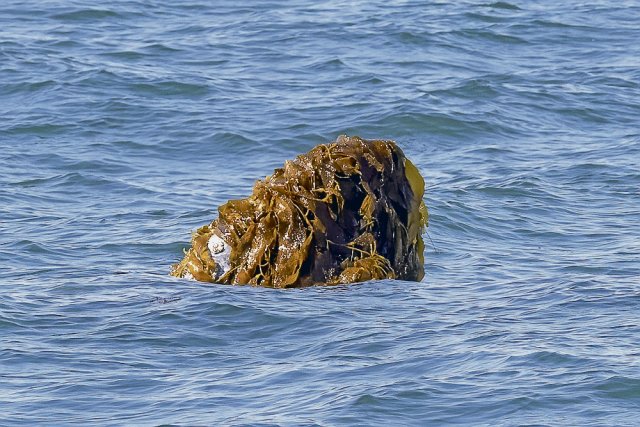A gray whale has its head wrapped in seaweed.
Photo: Olaf Meynecke
Whales playfully put seaweed on themselves as a “hat” or use it to exfoliate when they feel itchy. Whale researcher Olaf Meynecke, who works at Griffith University in Australia, has in a new Research work some bizarre behavior of whales has been documented.
“We have collected over 100 examples of whales playing with algae on social media,” reported the scientist. The playful behavior known in Australia as “kelping” is not unique to any particular species. On the contrary: all whale species – from gray whales to humpback whales – seem to have a preference for the “green stuff” in the sea, which has clearly become their favorite toy.
Hilla Kella, a research assistant at Griffith University who helped build a database of “kelping” photos and videos, said she had “never heard of this whale behavior” before. But when she started working, she was “very surprised” at how many of these events had already been posted on social media. Whales were seen wearing hats made of algae or were photographed “throwing the algae out of the water with their fins.”
Although a number of examples of whales’ playful and sometimes quite bizarre behavior can be found on social media, “kelping” has hardly been discussed in the scientific literature. Before Meynecke there is only one other Australian one Study from 2011 and described the interactions purely as playful behavior.
Against itching and bacteria
However, Meynecke derived significantly more aspects from the data he collected. On the one hand, he also considers the behavior to be playful, but on the other hand, in his opinion, it also has several useful components. For example, the whales would use the algae to rub when they feel an itch. Some types of algae also reduce bacterial growth. The latter can be useful for whales because their skin harbors a number of viruses and bacteria. Whales have to constantly shed their skin to keep bacterial growth in check.
The algae could also help the whales get rid of unwanted guests, such as barnacles and sea lice in the early stages of life. The lice are parasites “that drive the whales crazy,” as Meynecke described it. “Because whales are so large, many species of invertebrates are carried away by them or spend their entire lives on the mammals – often to the annoyance of the whales,” said the researcher. He reported how gray whales off the coast of Mexico had repeatedly turned to humans for help against the itchy sea lice, which are more closely related to shrimp or small crabs than to lice. Similar behavior has already been observed in other marine mammals. For example, dolphins in the Red Sea rub themselves against sponges and soft corals – presumably to relieve skin diseases. Green sea turtles also use corals and stones to clean their shells.
Busy for up to an hour
The kelp that the whales love to play with is a very strong algae and is excellent for romping around as well as for peeling. So far, seaweed play has been documented in Australia, the USA and Canada. But this is probably only because there are more people in these regions who watch whales and use social media platforms to share their observations.
Although most of the recordings come from the Internet, Meynecke himself also managed to document and examine several examples of the behavior using a drone. “In several drone videos we were able to observe humpback whales actively searching for algae,” he reported. These interactions were not just fleeting. “Whales can play persistently with the seaweed and occupy themselves with the algae for up to an hour.”
According to Meynecke, the mammals are not possessive. Rather, they willingly share their seaweed with other whales. In addition to entertainment and beauty care, the German researcher sees even more advantages of “kelping” for the whales. These include improving the whales’ coordination and movement skills. According to Meynecke, balancing algae on their heads could also be stimulating or pleasantly ticklish for the whales, as they have fine hair follicles on their top heads.
Other observations indicate that whales are generally quite playful creatures. Researchers have documented cases in which whales moved tree trunks through the water in Colombia or interacted with jellyfish on the east coast of the USA. In 2021, drone footage showed another strange behavior: in this case it was about the feeding behavior of humpback whales. The animals were filmed blowing bubbles from the nose on top of their heads. They used the bubbles to catch their prey – fish or krill – by driving them together in a kind of ball. Even in this seemingly playful behavior, the whales worked together with other whales.
Become a member of the nd.Genossenschaft!

Since January 1, 2022, the »nd« will be published as an independent left-wing newspaper owned by the staff and readers. Be there and support media diversity and visible left-wing positions as a cooperative member. Fill out the membership form now.
More information on www.dasnd.de/genossenschaft
sbobet link sbobet judi bola sbobet88
